Posts Tagged ‘Stigmata’
Saint Francis of Assisi: His Life and His Prayer
“All the darkness in the world can’t extinguish the light from a single candle.”
~ Francis Of Assisi (The Little Flowers of St. Francis of Assisi)
“If you have men who will exclude any of God’s creatures from the shelter of compassion and pity, you will have men who will deal likewise with their fellow men.”
~ Francis of Assisi
“While you are proclaiming peace with your lips,
be careful to have it even more fully in your heart.”
~ Francis of Assisi
“The deeds you do may be the only sermon some persons will hear today”
~ Francis Of Assisi
“Vi volglio tutti in paradisio!” [ “I wish all in heaven!”]
~ Francis of Assisi
“Above all the grace and the gifts that Christ gives to his beloved is that of overcoming self.”
~ Francis of Assisi
“When we pray to God we must be seeking nothing — nothing.”
“We should seek not so much to pray, but to become prayer.”
~ Francis of Assisi
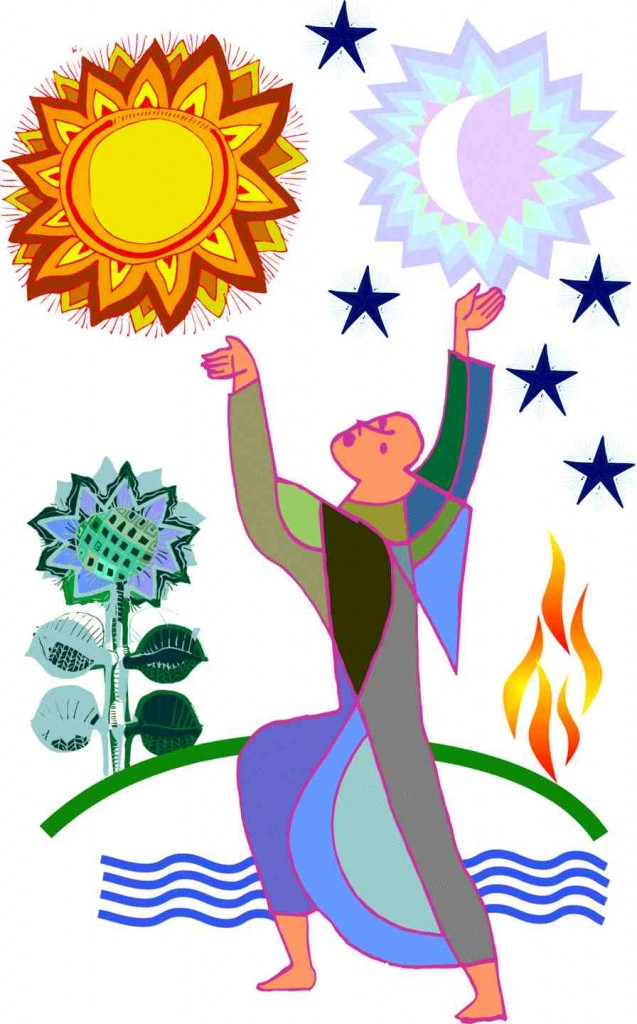
Saint Francis of Assisi ~ September 26, 1181 – October 3, 1226
Saint Francis of Assisi
[*See footnotes]
Saint Francis of Assisi is one of history’s most beloved saints. For almost eight hundred years since his canonization by the Catholic Church (in the year 1228), he has been remembered and revered not only by Christian denominations, but by countless others world-wide, who have been inspired by his life of universal love, his teachings, and his oneness with Nature.
More than three million people come every year to his tomb in Assisi.
He is patron saint of Italy and of many other places, like San Francisco, a city blessed with his name, his spirit, and a national shrine including the Porziuncola Nuova, the only papally declared holy place in the USA. Also, he is patron saint of birds, animals and ecology and is so remembered on his annual October 4th Feast Day celebration.
Francis loved peace, communed with all living creatures, and lived a life of kindness, simplicity and poverty in contrast to the wealth and apparent corruption of the Church. He was the founder of the Franciscan order of the Catholic Church, and inspired founding of the Poor Clares order for women, and a third secular order for laity sworn to peace.
After living a worldly life of youthful revelry for the first half of his short lifespan, Francis volunteered to fight in a war between Assisi and neighboring Perugia. He was captured during a bloody battle at Collestrada, and was imprisoned and chained in solitude for a year in a dark Perugian dungeon, until ransomed by his wealthy father. Beginning during this time, and thereafter, he suffered a period of protracted physical and psychological illness, remorse and reflection. After fervent prayer, deep introspection, and profuse tears, Francis ultimately decided that money and worldly pleasures meant nothing to him, and as a traumatized battle survivor he came to abhor war. Whereupon, he devoted his life to solitude, prayer, helping the poor, caring for lepers, and promoting peace. Seeing himself as God’s troubadour or fool, he lived in absolute poverty, patterning his life after the life of Jesus and dedicating himself to God.
On returning from a pilgrimage to Rome, where he begged at Church doors for the poor, Francis received a mystical message from Jesus while praying in the ruined church at San Damiano outside of Assisi. There while he was enchantedly gazing at the painted wooden crucifix – a Byzantine image of the crucified Christ still alive on the cross – the silent voice of Jesus telepathically ‘spoke’ to Francesco, instructing him: “Francesco, Francesco, go and repair my house which, as you can see, is falling into ruins.” Thereafter, he devotedly began rebuilding San Damiano and other ruined churches.
Though Saint Francis took literally that mystical message from the crucifix, its true meaning was metaphoric and profound. And by the end of his short lifespan, Saint Francis and his orders had by their example inspired a renaissance of the Catholic Church.
Francis’ exemplary lifestyle inspired and attracted followers who joined with him in his in his Divine mission and life of poverty. Clad in ragged, gray robes with rope belts, they went out barefoot in pairs to spread the Gospel. When they needed food or shelter, they asked someone for it. It was against their rules to “own” anything. Thus, they were known as the “begging brothers”.
In 1209 Francis received permission from Pope Innocent III to form a brotherhood, a religious order of the Church called the “Friars Minor,” (littlest brothers). As “friars” they worked in communities, actively preaching and helping residents, as distinguished from “monks” who then usually lived alone in isolated places. They soon acquired the name “Franciscans”, proliferated and today remain important international symbols and instruments of Francis’ legacy.
The Franciscans’ first headquarters was a simple, tiny chapel near Assisi which Francis received from the Benedictines, and personally restored, naming it “Porziuncola” [“a small portion of land”]. The Porziuncola became Francis’ most beloved and favorite place. Because of his presence and prayers there, it was and continues to be one of the world’s rare holy places. Here, Francis lived, fervently prayed, wrote his rule, created his order of friars minor and consecrated his friend Clara (Chiara), who became Santa Clara, founder of “the poor Clares”, a female religious order dedicated to Franciscan ideals of holiness and poverty. Francis so loved this little place that he chose to die there.
In 1216, while Francis was fervently praying in the Porziuncola, a light filled the chapel and he beheld above the altar a vision of Christ, the Virgin Mary and a company of angels. They asked him what he wanted for the salvation of souls. Francis replied: “Vi volglio tutti in paradisio!” [I wish all in heaven!] And Francis then asked that all those persons who shall come to this church, may obtain a full pardon and remission of all their faults, upon confessing and repenting their sins. The request was granted based on Francis’ worthiness, and the indulgence was later officially confirmed by Pope Honorius III, and became known as “The Pardon of Assisi”.
Francis was extremely democratic and humble. He referred to himself as “little brother Francis” and called all creatures “brothers” and “sisters”. He loved Nature and pantheistically considered it to be the “mirror of God on earth.” He spoke of “Sister Water” and “Brother Tree” and in one of his writings, he referred to “Brother Sun” and “Sister Moon”. There are legends about sermons he preached to trees full of “Sister Birds” in which Francis urged them to sing their prayers of thanks to God. And it is said that rabbits would come to him for protection.
In another legendary story, Francis spoke to a wolf which had been terrifying the entire village of Gubbio, scolding “Brother Wolf” for what he was doing. That wolf not only stopped his attacks but later became a village pet, and was fed willingly by the same villagers, who missed “brother wolf” after he died.
Francis was determined to live the gospels and was strongly influenced and motivated by Jesus’ teachings. “Give to others, and it shall be given to you. Forgive and you shall be forgiven” were his frequent teachings.
Also as a traumatic battle survivor and war hostage Francis cherished peace. So, “Blessed are the peacemakers, for they will be called children of God.” ~ Matthew 5:9 and “love your enemies and pray for those who persecute you.” ~ Matthew 5:44 were often recited by him.
According to a recent biography, Francis was “the first person from the West to travel to another continent with the revolutionary idea of peacemaking.” On a mission of peace, Francis journeyed to Egypt in 1219 idealistically hoping to end the 5th Crusade by converting the Egyptian leader – Sultan Malik al-Kamil – to Christianity. Though his visionary peace mission did not succeed, it proved nonetheless a miraculous portent and important symbol of potential reconciliation between Christians and Muslims and others.
At a time when most Christians demonized Muslims as enemy “infidels”, Francis regarded and treated Muslims with respect, never echoing the negative comments or conduct of his contemporary Christians. Moreover, in Egypt Francis – a devout and gentle peacemaker – was appalled by the crusaders’ sacrilegious brutality.
Francis arrived in Egypt during an ongoing violent and bloody conflict at Damietta, an important city on the Nile, besieged by the Crusaders. There, in the midst of horrible bloodshed, Francis miraculously crossed battle lines totally unarmed and vulnerable, and was able to reach the Sultan’s encampment unharmed and welcomed. Moreover, Francis was admitted to the august presence of the sultan, who was nephew of the great Saladin who had defeated the forces of the ill-fated Third Crusade.
The Sultan was a wise and pragmatic devout Sunni Muslim, influenced by Sufi mystical teachings. He was ready to make peace, and reciprocated Francis’ peaceful and respectful attitude. For at least several days Kamil hosted and dialogued with Francis as an honored guest, before having him safely escorted back to the Crusader encampment. The Sultan – who was amenable to philosophical conversation, but not to conversion – probably noted and honored Francis’ sufi-like appearance and peaceful demeanor, and his regular greeting – “may the Lord give you peace” – uncommon for Christians, but similar to the Arabic “salam aleykum” greeting.
Reciprocally, Francis was deeply impressed by the religious devotion of the Muslims, especially by their fivefold daily call to prayer – call of the muezzin.
On returning to the crusader camp Francis desperately tried to convince Cardinal Pelagio, whom the pope had authorized to lead the 5th Crusade, that he should make peace with the Sultan. But the cardinal who was certain of victory would not listen. His eventual failure, amidst terrible loss of life, brought the barbaric age of the crusades to an ignominious end.
In 1224, near the end of his earthly life, according to legend, Francis became the first saint in history to miraculously receive crucifixion stigmata. It happened after he had been taken to Mount Alverna, a wild nature place in Tuscany, to be in solitude for a forty day retreat.
Though already in a very feeble state, he fasted and prayed intensely with deepest longing for God. In the midst of his fast, while he was so praying he beheld a marvelous vision: an angel carrying an image of a man nailed to a cross. When the vision disappeared, Francis felt sharp pains in various places on his body.
In locating the source of these pains, Francis found that he had five marks or “stigmata” on his hands, feet, and sides—like the wounds inflicted with nails and spears on Jesus during His crucifixion. Those marks remained and caused Francis great pain until his death two years later.
On October 3, 1226 A.D. Francis died in a humble cell next to the beloved Porziuncola, his favorite holy place where the Franciscan movement began. He was blind from trachoma, suffering from malaria and other illnesses, emaciated and racked with pain from the stigmata and other wounds. As he lay dying, the brothers came for his blessing. They sang “Song to the Sun”, a song which Francis had composed.
Sometime before he drew his last breath, he said, “Let us sing the welcome to Sister Death.” Francis welcomed ‘Sister Death’ knowing that “it is in dying that we are reborn to eternal life”, the concluding line of a beautifully inspiring and best known peace prayer mistakenly attributed to him. (**See Footnote)
In conclusion, we offer that prayer in grateful tribute to his blessed life and legacy. May he ever inspire countless beings to become instruments of Divine peace and love, in perfect harmony with Nature and the kingdom of heaven.
“Vi vogliamo tutti in Paradiso”; “We wish ALL in Heaven”.
And so it shall be!
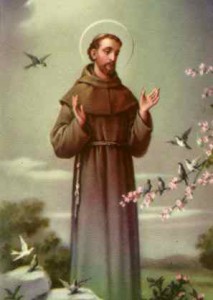
Prayer Of St. Francis Of Assisi **
Beloved, we are instruments of Thy peace.
Where there is hatred, let us sow love;
Where there is injury, pardon;
Where there is doubt, faith;
despair, hope;
darkness, light;
discord, harmony;
sadness, joy;
Divine Mother/Father, grant
that we may seek not so much
to be consoled as to console;
to be understood as to understand;
to be loved, as to BE LOVE.
For it is in giving, that we receive;
It is in pardoning, that we are pardoned;
And it is in dying – to ego life –
that we are reborn to Eternal Life.
Ron’s audio recitation of the Prayer of Saint Francis Of Assisi
Footnotes
* This narrative is based on Ron Rattner’s intuitive interpretation of many disparate and sometimes conflicting historical accounts of the life of Francis of Assisi. The reader is free to accept or reject any part of it.
**This inspiring peace prayer does not appear in any of Saint Francis’ known writings. According to researchers, the first appearance of this prayer was in a French language magazine, La Clochette, in 1912; it was probably then first written by a forgotten Catholic Priest, Father Bouquerel. Later, the prayer was translated into English and widely distributed on cards with a reverse side picture of Saint Francis, without any claim that he wrote the prayer. But, because of his picture and because it invokes his spirit, the prayer thereafter became commonly known as the Prayer of Saint Francis. The foregoing version of the prayer has been edited by Ron Rattner.
Pilgrimage to Assisi : Communing With Saint Francis ~ Ron’s Memoirs
“All the darkness in the world cannot extinguish the light from a single candle.”
~ St. Francis Of Assisi (The Little Flowers of St. Francis of Assisi)
“If you have men who will exclude any of God’s creatures from the shelter of compassion and pity, you will have men who will deal likewise with their fellow men.”
~ St. Francis of Assisi
“The deeds you do may be the only sermon some persons will hear today”
~ St. Francis Of Assisi
Pilgrimage to Assisi: Communing With Saint Francis
Introduction
On moving from Chicago to San Francisco in 1960, I knew virtually nothing about saints and was largely uninformed about religions other than Judaism. Even though Saint Francis of Assisi was patron saint of my new home town, I remained ignorant of his life story until after my profound spiritual opening in 1976.
Then, about two years before meeting my Guruji, Shri Dhyanyogi Madhusudandas, I began having synchronistic inner and outer experiences concerning Saint Francis of Assisi, of whom I was previously ignorant. Because of those experiences I developed deep affinity with and great curiosity about this legendary saint, and regarded Saint Francis as an archetype to be emulated.
Soon I began and have ever since continued daily recitations of the “make me an instrument of Thy peace” prayer associated with him. But I was unable to satisfy my curiosity about Saint Francis until ten years after to my 1982 pilgrimage to India. Then on retirement from legal practice in 1992, I made pilgrimages to India and later to Italy to honor my beloved Guruji and ‘Francesco’.
In spring 1992, I journeyed to the Umbrian town of Assisi, Italy, where Saint Francis was born and resided for most of his inspiring life, and where I experienced an extraordinary feeling of déjà vu, like that experienced in India at the temple home of Shri Ramakrishna Paramahansa in 1982. My pilgrimage stay in Assisi and an excursion to Mount La Verna in Tuscany – where Francis became the first saint to receive the crucifixion stigmata of Christ – proved magical, There, with intense and tear-laden emotion of devotion, I was blessed with a few of the most memorable spiritual experiences of this lifetime, which I will hereafter recount.
Arrival at Assisi and Worshiping at Tomb of St. Francis.
I arrived at the Rome airport on a Spring evening in 1992. After sleeping that night at an airport hotel, the next morning I rented an auto and drove north toward Assisi. Instead of taking the fastest autostrada route, I elected a slower scenic route. After a few hours I came to a sign announcing that I was entering Assisi. Immediately after the sign there was a rightward road bend whereupon I beheld a vista of my intended destination – the beautiful Umbrian town of Assisi, where St. Francis was born and resided for most of his extraordinary life.
Almost immediately thereafter I was obliged to pull off the road, in a turnoff place.
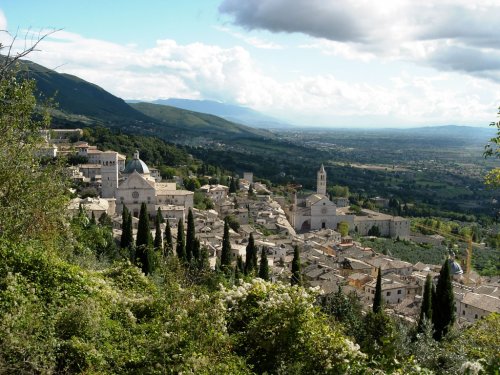
Assisi, Italy
I couldn’t drive further because I began crying spontaneously and intensely, with deep emotion sparked by a mysterious feeling of déjà vu that I had returned to a beloved and familiar place. Only after shedding many tears was I able to resume driving to my destination – the Ananda Spiritual Retreat Center in the Umbrian hills outside Assisi – where I stayed during my pilgrimage there.
The Ananda center had been founded by Swami Kriyananda, a prominent direct disciple of Paramahansa Yogananda, who in Autobiography of a Yogi referred to St. Francis as an “apostle of humility”. So, it seemed an ideal place for me stay as a “born-again Hindu” devotee of St. Francis.
According to Swami Kriyananda:
”St. Francis of Assisi was Paramhansa Yogananda’s “patron saint.” Yogananda had at least two visions of St. Francis that he spoke of — one during a visit to Assisi, Italy in 1936, and another at Mt. Washington that inspired his beautiful poem, “God, God, God.” Yogananda admired the renunciation and simplicity of St. Francis.”
After sleeping my first night at the Ananda center, the next day I drove into Assisi. With continuing déjà vu I walked through medieval streets of that lovely town experiencing a sweet and mysteriously familiar ambience. Then I visited the giant Basilica of Saint Francis, under which the great saint is entombed. Near the crypt containing his remains there were continuing Masses being celebrated consecutively in various languages for pilgrims from places worldwide.
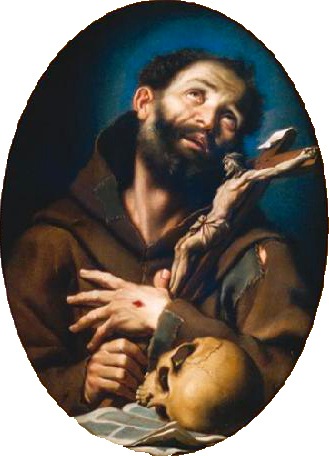
St. Francis of Assisi
As a secular Jew transformed to “born-again Hindu”, who spoke only English, I had never before participated in a Catholic mass. However, irresistibly I attended several consecutive masses in various languages which I didn’t understand. But my heart knew the pervasive sweet and familiar ambience which I had experienced outside the Basilica, and which had become intense for me near Franceso’s tomb beneath the Basilica. And I was compellingly drawn to it.
Eight hundred years after Saint Francis had walked in that lovely Umbrian town it seemed for me that it was everywhere still pervaded by his sweet life-force shakti; with its emanation being especially intense at the site of his entombed remains. Afterwards I unforgettably experienced that same familiar life-force emanation at other Assisi shrine places.
Hereafter I will tell you about three more memorable experiences of communing with the spirit of St. Francis in Italy.
Discovering the Porziuncola

Porziuncola within Basilica
One of the most profound of those experiences happened as I visited a tiny frescoed chapel outside Assisi called by Francesco Porziuncola [“the little portion”]. He and his early followers had restored it from a ruined condition to become first home of the Franciscan order. And it was Francesco’s favorite place on earth.
Here, he lived, fervently prayed, wrote his rule, created his order of friars minor and consecrated his friend Clara (Chiara), who became Santa Clara, founder of a female order dedicated to Franciscan ideals of holiness and poverty. Francis so loved this little place that he chose to die there.
In 1216, Francis had a legendary vision in the little chapel. After fervent and tearful prayers, a light filled the chapel and he saw above the altar Christ, the Virgin Mary and a company of angels. They asked him what he wanted for the salvation of souls. In response Francis requested that all those who might enter the chapel and contritely repent their sins be granted a pardon and remission of all such sins. Whereupon Francis was told by the heavenly host that his request was granted.
Thus, the Porziuncola was thereafter Papally blessed with “The Pardon of Assisi” so that those who enter and repentantly pray there are pardoned of their sins, and it has been proclaimed a ‘world holy place’.
Having paid respects to Saint Francis at the basilica where he is entombed, my next pilgrimage destination was the Porziuncola. But I went there unprepared for what I saw. In reading biographies of the saint I had focussed on his simplicity and humility and somehow missed description of the giant basilica which had enveloped his beloved tiny headquarters chapel.
I didn’t realize until then that by Papal order, three hundred fifty years after Francis’ death, the great Basilica of Santa Maria degli Angeli (Saint Mary of the Angels) was erected over the simple Porziuncola chapel – Franceso’s “little portion” – and that all its original outbuildings were demolished, except the simple cell where Francis died. So I felt a bit bewildered on approaching and entering the grandiose basilica – so inconsistent with Francis simple life and message – and wondered what he might say about it.
But I found my way to the tiny chapel which was situated directly beneath the basilica cupola. And after waiting in line with others, I was able to enter and sit in the tiny and simple Porziuncola. With renewed déjà vu, I immediately experienced an almost palpable aura of the saint’s supernal love, and spontaneously cried deeply and intensely. I was so overcome with emotion that I lost track of time.
On regaining my senses, I realized with a guilty conscience that I had overstayed my time there, while other pilgrims waited in line for a chance to enter, and perhaps to repent and be absolved of their sins. So in a highly “enshakticated” [love intoxicated] condition I slowly got up and walked out. With continuing déjà vu I strolled to the place there where Francis died on October 3, 1226. Then, still in an altered state of awareness, I returned to the Ananda center after one of the most memorable experiences of this lifetime.
Memory of that exquisitely simple little chapel and its aura of supernal Love has remained enshrined in my heart ever since my one visit there. Although I have never since returned to that holy Assisi place, which Saint Francis named and loved, my cherished memory of the Porziuncola was revived following a surprising and synchronistic ‘holy encounter’ and discovery – almost thirty years later – of a San Francisco Porziuncola Nuova. Never have I thereafter entered that San Francisco holy place without experiencing supernal love and tear laden emotion of devotion as in my pilgrimage to the Assisi Porziuncola.
An Unforgettable Experience at the Church of San Damiano
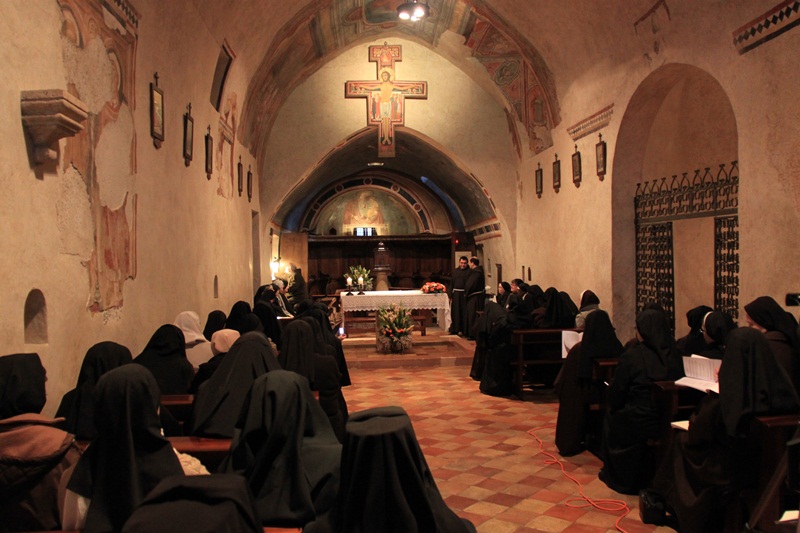
Church of San Damiano
Biographers of Saint Francis all agree that he had a transformative experience in an old and semi-abandoned church just below Assisi – the Church of San Damiano. There while he was enchantedly gazing at the painted wooden crucifix – a Byzantine image of the crucified Christ still alive on the cross – the silent voice of Jesus telepathically ‘spoke’ to Francesco, instructing him: “Francesco, Francesco, go and repair my house which, as you can see, is falling into ruins.” Thereafter, he devotedly began rebuilding San Damiano and other ruined churches, including the Porziuncola.
While repairing San Damiano, Francis often sang songs which spontaneously came to him. And he thereby attracted neighboring farmers and other visitors, presciently telling them that this ruined church would some day become a holy place attracting servants of God. And it did. As Francis predicted it was here that his friend Clara (Chiara), who became Santa Clara, founded Poor Ladies of San Damiano a female order and lived a cloistered life dedicated to Franciscan ideals of holiness and poverty.
Though Saint Francis took literally Jesus’ mystical message from the San Damiano crucifix, its true meaning proved metaphoric and profound. And by the end of his short lifespan, Saint Francis and his order had by their example inspired a renaissance of the Catholic Church from its then apparent corruption by worldly wealth.
Thus, as a pilgrim honoring Saint Francis, one of my most important planned destinations was the Church at San Damiano. At the Ananda Center I was urged to visit San Damiano for early morning mass then being celebrated by Franciscan Friars with beautiful ecclesiastic chanting. In following that advice, I was blessed with one of the most memorable and beautiful experiences of this lifetime.
Here is what happened.
My drive from the Ananda Center to San Damiano proved extraordinary. It was a sunny and beautiful spring morning, with azure blue sky and small white cumulous clouds. On turning off onto the quiet country road leading to my destination, the verdant landscape was ethereally beautiful – abounding with gorgeous blooming wild flowers. As I beheld this beauty it seemed as if I was enjoying a waking dream of being in heaven on earth. And again it invoked that sweet feeling of déjà vu which followed my first vista of the Assisi environs.
Thus, I arrived at the San Damiano chapel already in a somewhat ‘altered’ state of awareness, just as mass was about to begin. At the chapel portal I was surprised to see that the entire small sanctuary was already filled with people, and that I could not observe any remaining place to sit. So, as the chanting began, I stood at the chapel entry and began weeping with deep emotion of devotion. On observing me crying there, some compassionate worshippers squeezed together to make space for me to sit down.
Thereupon I sat down and continued crying with even greater emotional intensity. That is all I can remember of the mass.
Spontaneously, I went into a very deep state of meditation and lost all consciousness of what was happening. I don’t recall how long I was in that state. But when I awakened from it, there was not a soul in sight. I was seated all alone in the San Damiano chapel still in an ‘altered state of awareness’ and gazing at its painted wooden crucifix. * [see footnote].
Thereupon, a ‘silent voice’ from the crucifix telepathically said to me: “Ritorna a me!” – a message in Italian which I did not immediately understand.
For a while, my mind remained silent and my body remained still. When I finally reawakened to ‘normal’ body consciousness, I urgently needed to use a toilet. So I got up and left the chapel to find one.
But still there was not a soul in sight from whom I could get directions. So I wandered the empty corridors until soon seeing what appeared to be public rest rooms. But there were no signs with international gender symbols identifying them. Instead there were different Italian words on each door. But I couldn’t translate either of them. So, after momentary reflection, impelled by an urgent ‘call of Nature’ I entered what I guessed to be the men’s room. But I guessed wrong. Embarrassed, I made a quick exit, and used the other bathroom.
I left San Damiano wondering why God had addressed me in Italian, when I was so ignorant of that language that I couldn’t even find the men’s room.
Of course I soon learned – and will never forget – that “Ritorna a me!” meant “Return to me!” And I took it as a Divine message. Since then I have come to realize that, knowingly or unknowingly, every embodied human soul longs to return to its Divine Source. But that virtually all of us, including Ron, need frequent reminders of that eternal Truth.
Thus, I recall my extraordinary experience at San Damiano as such a reminder.
* This crucifix was an exact replica of the original crucifix worshipped by Saint Francis and Santa Clara, which for preservation had been previously removed to the Basilica of Santa Chiara in Assisi.
Excursion to Mount La Verna in Tuscany
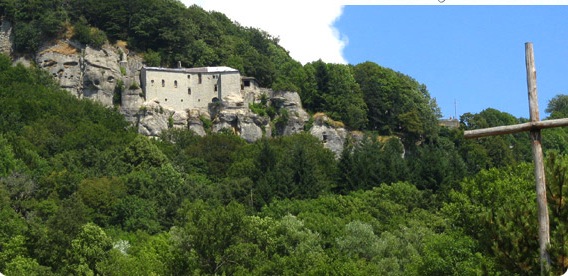
Mount La Verna Sanctuary
Notwithstanding my marvelous experiences of Saint Francis in and around Assisi, there remained on my pilgrimage itinerary an important place outside Assisi, Mount La Verna in Tuscany – where Francis became the first saint to receive the crucifixion stigmata of Christ. And also there remained for me great curiosity and a desire to solve the mystery of why – as a secular Jewish lawyer ignorant of Christian saints – I had developed a deep inner rapport with and love for Saint Francis, even before I had met my beloved Hindu Guruji, Shri Dhyanyogi Madhusudandas.
Before my midlife spiritual awakening, I had no inner visions and rarely remembered dreams. And even if I remembered them they were colorless and commonplace. But soon after my rebirth experience I had two repetitive extraordinary and mysterious visions or vivid dreams unlike any prior inner experience.
Twice, in semi-somnambulant states, I clearly perceived – like a slow motion ‘inner technicolor movie’ – a scene which I was viewing from a high aperture or window in a medieval building. * [see footnote]
I could not see any person at the aperture, but only experienced my consciousness being there and looking out. Below me were monks or friars clothed in simple robes or habits in a verdant open space midst trees surrounding the medieval structure from which ‘I’ was viewing them. Especially noteworthy was the extraordinary etherial light around that scene, which I immediately associated with Tuscany, the Italian state just North of Umbria, where I had visited in 1955.
So in 1992 I was anxious to visit Mount La Verna in Tuscany not only because Francis had his ultimate spiritual experience there, but also because of curiosity about those mysterious visions. However, because of my ignorance of the Italian language I was reluctant to journey alone from Umbria to La Verna. Then, synchronistically, a friendly multi-lingual Ananda center staff member familiar with La Verna and intermediate sites visited by Saint Francis compassionately offered to be my driver and tour guide for a full day’s excursion to those places.
The entire excursion proved a memorable experience in my already wonderful visit to Italy. With great interest, I saw various places known to Saint Francis. For example, we stopped at the town of Gubbio, where the saint is still venerated for legendarily confronting and taming a fierce wolf which was attacking townspeople and their livestock.
But for me our visit to the Mount Laverna sanctuary in the Tuscan Appenines proved the highpoint of our journey. Upon our arrival at La Verna, I immediately intuited – as we observed the grounds and structures there – that La Verna was the place in Tuscany which had appeared in my mysterious inner movie visions eighteen years earlier. Then, I meditated in a wooded area where, with renewed déjà vu, I again felt the supernally sweet presence of Saint Francis. As we departed from that lovely place, I felt great gratitude for our visit there, yet with continuing curiosity about the visions which had long preceded the visit.
Though I have ever since strongly felt that La Verna was the place which appeared in those early visions, their meaning remains an unsolved mystery. Perhaps in another lifetime I was at that place, when or after it was visited by Saint Francis. But I don’t know. And it’s probably not important that I know.
The Buddha taught that we should avert speculation which will not lead to edification. And speculation about imagined other life times can perhaps detract from fulfillment in this lifetime.
*I am describing these visions from memory, because I have not yet found any contemporaneous notes from over thirty years ago. After experiencing these visions I began regarding similar ‘inner movies’ as glimpses of other lifetimes.
Conclusion
My experiences of communion with Saint Francis of Assisi in places where he lovingly lived eight hundred years ago were memorably inspiring reminders of our human potential for humbly living a life of eternal love, even under difficult external circumstances. They strongly reinforced my continuing view of that great saint as an archetype to be emulated.
For an experience of the inspiring ambience bequeathed to us by Franceso’s life of love and humility, I highly recommend your viewing “Brother Sun, Sister Moon”, a 1972 film, masterfully directed by Franco Zeffirelli. Based on the life and legend of Saint Francis of Assisi, this two hour film is exceptionally beautiful and inspiring.
